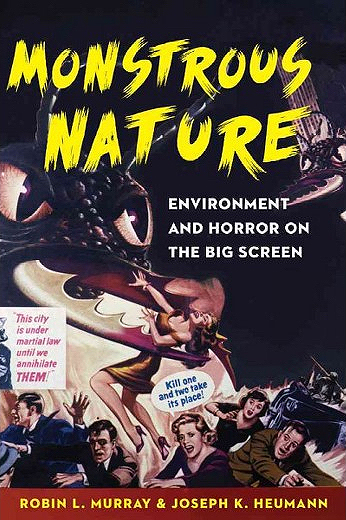‘Monstrous Nature’
Authors reveal how horror films create human and non-human monsters in eco-cinema book
By Laurie B. Davis

An alumna of The University of Toledo and a film scholar, Dr. Robin L. Murray (A/S ’91,’94) shares that attitude with respect to bugs and would happily hold them. “Absolutely! Insects fascinate me.” Murray says, “‘Beetle Queen’ definitely is trying to highlight how we need to have insects and have a good relationship with them because they’re part of the ecosystem.”
She describes herself as a strong advocate for the environment and has become more acquainted with bugs through film studies and writing eco-cinema criticism. Considered a fairly young area of study, with most eco-cinema literature published after the 1990s, the focus on analyzing films with environmental themes is growing, and Murray and her co-author Joseph K. Heumann are part of its momentum.
Murray, a professor of English and women’s studies, and the coordinator of the film minor at Eastern Illinois University, has co-written with Heumann five eco-cinema criticism books: “Ecology and Popular Film: Cinema on the Edge” (SUNY Press 2009), “That’s All Folks?: Ecocritical Readings of American Animated Features” (U Nebraska Press 2011), “Gunfight at the Eco-Corral: Western Film and the Environment” (U Oklahoma Press 2012), “Everyday Eco-Disasters” (U Nebraska 2014), and “Monstrous Nature: Environment and Horror on the Big Screen” (2016).
Natural monsters
 Their latest book, “Monstrous Nature,” examines four recurring environmental themes that emerge in horror films: anthropomorphism, human ecology, evolution and gendered landscapes. The authors focus on the messages the films deliver when looked at through their critical lens. “The messages they convey connect explicitly with current environmental issues,” says Murray. In the films viewed for their studies, “Nature is constructed as monstrous by highlighting how things other than humans are like our worst selves,” says Murray. “There’s an explicit connection between human action and monstrous results such as climate change, toxic waste and radiation poisoning. All of those things that create not only monsters but also monstrous conditions.”
Their latest book, “Monstrous Nature,” examines four recurring environmental themes that emerge in horror films: anthropomorphism, human ecology, evolution and gendered landscapes. The authors focus on the messages the films deliver when looked at through their critical lens. “The messages they convey connect explicitly with current environmental issues,” says Murray. In the films viewed for their studies, “Nature is constructed as monstrous by highlighting how things other than humans are like our worst selves,” says Murray. “There’s an explicit connection between human action and monstrous results such as climate change, toxic waste and radiation poisoning. All of those things that create not only monsters but also monstrous conditions.”
The authors’ move from animation and Westerns to horror flicks was a progression inspired by two films, one from 1971 and another from 2009. “I think what really sparked our interest in this further is that we saw a few insect documentaries and were so excited to see how they were anthropomorphizing the insects to show how interesting they are, but also turning them into monsters.” Murray is referring to “Beetle Queen Conquers Tokyo” and “The Hellstrom Chronicle.”
Anthropomorphism, the attribution of human characteristics or behaviors to a god, animal, object and, yes, insects, emerges in “The Hellstrom Chronicle.” The film, which visually dramatizes the power of insects over humans, won the Academy Award in the documentary feature category. The film’s cinematography magnifies the size of the insects, emphasizing their sounds and behaviors, while the narrator seems to invite viewers to debate his theories about insects outliving man. Described as soldier-like and indestructible, the insects are portrayed as stronger and smarter than humans.
The relationship between humans and their environment has been at the heart of many movie plot lines, and when it comes to horror films, that relationship typically is adversarial. Filmmakers in the horror genre often transform inhabitants of the natural world — insects, amphibians, reptiles, and wild creatures of all types — into gigantic, menacing monsters that attack humans. Most often, the attacks are motivated by human mistreatment or exploitation of the environment.
Monster fame and intelligent frogs
Perhaps the most famous monster is Godzilla. In 1954, Japanese filmmakers unleashed an enormous reptile with atomic breath. Numerous remakes of “Godzilla” have appeared in movie theaters since, but the original version from Japan, called “Gojira,” directly addresses nuclear activities in its dialogue: “I can’t believe that Godzilla was the only surviving member of its species … But if we continue conducting nuclear tests, it’s possible that another Godzilla might appear somewhere in the world again.”
While Godzilla may have emerged from the sea, disturbed by “underwater hydrogen bomb testing,” he was not anthropomorphized. “In the big bug movies and any of the nature attack films, animals are given these human characteristics. Perhaps they’re able to intellectually take a superior stance to humans. The creatures are fighting against humanity’s actions, like in the movie ‘Frogs,’” says Murray.
In that 1972 film, amphibians on a Florida island appear to have the ability to communicate with fellow island creatures the need to exact revenge on the family living in this Everglades paradise. The patriarch, portrayed by Ray Milland, proudly displays the heads of wild animals from his big-game hunting — strike one — abuses pesticide use on the island — strike two — and confidently espouses man’s superiority over beast — strike three. Without growing disproportionately, the frogs outwit and outnumber the human island dwellers. Milland’s demise is left to the audience’s imagination, but in the end, there were a lot of frogs in the room with him.
What a devastated homeland can create
While many of the films Murray watches primarily focus on insects, others explore vampires, zombies and cannibalism. From a human ecology perspective, based on the philosophies of chemist and home economics pioneer Ellen Swallow Richards, humans have caused many environmental problems such as air and water pollution that they must resolve in order to live better lives. “What we’re looking at here is how to reconnect with Earth as home,” says Murray, regarding the human ecology theme.
A 2009 Romanian/British film called “Strigoi: The Undead” looks at how the blood of war can create the strigoi (another word for vampire). “A war-torn home can create monsters,” says Murray. “‘Strigoi’ focuses on post-Communism land deals based in corruption. It’s looking at how Romanian history in some ways destroys their homes. One character in the film has to move from one village to another because his land was taken from him through violence. The filmmakers make a strong connection between the vampirism and the blood of war.”
Murray says, “Strigoi” is one of her favorite horror films “because it mixes comedy with horror to address Romania’s bloody history. With a comic tone that comes close to satire, ‘Strigoi’ draws parallels between literal vampirism and struggles for land. Struggles that comment on the greed of dictators, such as Romania’s Nicolae Ceausescu, who destroy both human and nonhuman nature,” she explains. “Vampires rather than eco-trauma are the product of this devastated home, a soil desecrated by the blood of war or exploitation of human and nonhuman nature.”
A third recurring theme in eco-cinema horror films is evolution. “We’re looking at zombies in one chapter and looking at how zombie evolution can metaphorically highlight how we can have a relationship with other species,” says Murray. Zombie evolution is represented in such films as “Warm Bodies” and “Land of the Dead.” The clearest evolutionary representation comes from films about parasite evolution, Murray adds. “We looked at a documentary called ‘Poisoned Waters,’ which tells the story of how a small Chesapeake Bay town suffered a catastrophic onslaught of unpurified water because of a lot of runoff from farms. That affects the ecosystem of the bay, which changes the evolution of parasites.
“Barry Levinson made this found-footage film called ‘The Bay’ that explores some of the same kind of scientific evidence in ‘Poisoned Waters,’ but he was turning it into a more obvious fictional film. He’s trying to get the same kind of message across that we’re not only changing the waters, but we’re creating these parasites that destroy fish and therefore destroy humanity. It’s a really clear picture of the manipulation of the environment when it comes to evolutionary change,” she says.
The fourth theme that the film scholars analyze, gendered landscapes, throws a lens on cannibalism, manifest destiny, westward frontiers and gendered bodies. In this section of the book, Murray and Heumann write about such horror films as “American Psycho,” “Trouble Everyday” and “Ravenous.”
Finding a middle ground
Murray, who studied with Dr. Jamie Barlowe, dean of the College of Arts and Letters, earned her PhD in American literature. She says Barlowe introduced her to the kind of eco-critical studies she and Heumann pursue. “We’ve done a lot of work on the Western, which is really very much grounded in the work I did at UT,” says Murray, adding that a lot of the theory behind her current work came out of her PhD program.
Murray and Heumann’s latest project is “Eco-Cinema and the City.” “We’re hoping it’s a more positive representation of nature in films,” she says. “We wanted to look at the interdependent relationships between humans and nature, so we have a chapter on bird watching in Central Park and one on zoos. We’re looking at this move toward sustainable cities and urban gardening and farming, and also looking at making a city accessible to everyone and everything.”
The study of horror films from Murray and Heumann’s perspectives and the conclusions they draw may help illuminate how humans could seek balance with nature, much as the Japanese have accomplished. “For us, exploring film in relation to a monstrous nature expands and refigures definitions of horror in productive ways,” the two authors write in Monstrous Nature. “Such an exploration also demonstrates that the only viable solution to such ‘natural attacks’ is to seek a middle ground that sustains both human and non-human nature.”






